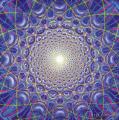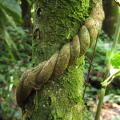
DMT-Nexus member

Posts: 1538 Joined: 24-Nov-2009 Last visit: 31-Aug-2024
|
Oral Caapi slows heart rate, lowers blood pressure, and is a vasodilator, right? Does it significantly depress breathing? Oral mimosa - does this raise heart rate, blood pressure, do any vasoconstricting? Any other random important things I am forgetting, re: the circulatory system or lungs? I need to have a chat with my doctor about dusting off some brew in the back of the freezer, but want to make sure I have my facts straight.  Thanks. Some things will come easy, some will be a test
|

DMT-Nexus member

Posts: 3090 Joined: 09-Jul-2016 Last visit: 03-Feb-2024
|
Caapi is also a broncholidator.
I suspect that DMT has more or less the same physiological effects as other, simmilar psychedelic tryptamines, in wich case it indeed would do some vasoconstricting. And it could be that it has some very, very mild bronchoconstricting effects as well, though i have never experienced this myself or have heard or seen it being mentioned anywhere. Some hallucinogenic tryptamines do this though, and some don't.
There could be some other beta-carbolines in mimosa, and i don't know what they would do if they are. Probably negligible.
Btw, how are you doing? I hope you had a good recovery from that corona infection.
|

DMT-Nexus member
Posts: 1111 Joined: 18-Feb-2017 Last visit: 12-Jul-2024
|
I don't think this has been studied, but anecdotally, people report brain zaps and jolts from MHRB tea.
|

DMT-Nexus member
Posts: 14191 Joined: 19-Feb-2008 Last visit: 11-Oct-2025 Location: Jungle
|
Ayahuasca physiological effects ( Dominguez et al 2016) Quote:From a physiological perspective, ayahuasca exerts sympathomimetic effects increasing norepinephrine turnover (Riba et al., 2003) and causing mydriasis (dos Santos et al., 2011).
It also increases blood levels of the stress hormones cortisol and prolactin (dos Santos et al., 2011). However, in contrast with the prominent cardiovascular effects reported for pure DMT in studies involving intravenous administration, we observed only moderate increases in systolic (SBP) and diastolic blood pressure (DBP) after ayahuasca, and practically no changes in heart rate. In a first pilot study involving 6 participants, we found marginally significant increase in SBP at a dose of 1 mg DMT/kg body weight. On average this increase was of 14 mm Hg. Average increases in DBP were of 10 mm Hg and 9 beats per minute in heart rate (Riba et al., 2001). In a subsequent study involving 18 participants and a lower 0.85 mg DMT/kg dose, we obtained inconsistent results. Blood pressure increased but only DBP reached statistical significance. SBP increased an average of 6 mm Hg, DBP an average 10 mmHg, and heart rate only 4 beats per minute (Riba et al., 2003). This low-to-moderate cardiovascular impact was further supported by a subsequent study in which we administered two consecutive 0.75 mg DMT/kg ayahuasca doses. The second dose led to higher DMT plasma levels than the first, but the increase was linear, showing a mere superposition over the DMT levels remaining from the first dose. This produced linear increases in subjective, neurophysiological and autonomic effects. However, there was a trend to reduced SBP and heart rate, suggesting tolerance for cardiovascular effects (dos Santos et al., 2012).
Based on the above studies, the B. caapi–P. viridis version ayahuasca appears to be reasonably safe in terms of physiological impact when administered to healthy individuals. The most common side effects are nausea and vomiting, especially if more than one dose is taken in a single session (Riba et al., 2001; dos Santos et al., 2012). And even this aspect of the experience is perceived in some contexts as beneficial ‘purging’. Several factors may contribute to the low toxicity of ayahuasca, such as selectivity of the beta-carbolines for the MAO-A isoenzyme, the rapid clearance of harmine from the organism, and the availability of MAO-independent biotransformation routes for DMT (Riba et al.,2015). These factors would explain the absence of reports of adverse reactions following the ingestion of foodstuffs containing tyramine after an ayahuasca session. However, as a precautionary measure, combining ayahuasca with other MAO inhibitors and serotonergic drugs such as antidepressants should always be avoided (dos Santos, 2013). Finally, from the perspective of psychological safety, there is the potential risk of anxiety reactions during the experience, as occurs with other psychedelics. Transient dissociative episodes have also been documented during ayahuasca intake. These effects are usually observed at high doses. In a clinical context, verbal support seems to be sufficient to help participants navigate these situations (Riba et al., 2001). More infrequently,longer-lasting psychotic symptoms have been reported in association with ayahuasca use (dos Santos and Strassman, 2011). Regarding harmalas/ayahuasca vasodilation, it seems there might be such effects but also vasoconstricting effects.. here's another quote from ( Brierley and Davidson 2012): Quote:Activation of central 5-HT2A receptors increases blood pressure via vasopressin (Knowles and Ramage, 1999), and in the heart activation of these receptors causes vasoconstriction via platelet activation(Satomura et al., 2002). Given DMT's and harmine's affinities at the 5-HT2 receptor one would predict that ayahuasca will have effects on blood pressure, and Riba et al. (2003) found ayahuasca to increase both systolic and diastolic blood pressures in humans. On the otherhand, the structurally related harmane evoked hypotension via imidazoline I2 receptors in the rat (Musgrave and Badoer, 2000)and caused vasorelaxation via release of nitric oxide from smooth muscle (Shi et al.,2000). and some of the vasodilation/vasorelaxant effects often quoted seem to be from in-vitro studies such as ( Berrougui et al 2006), not sure how relevant it would be for in vivo effects in humans.
|